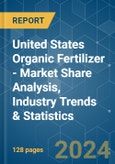The United States Organic Fertilizer Market size is estimated at USD 354.22 million in 2024, and is expected to reach USD 630.92 million by 2029, growing at a CAGR of 12.24% during the forecast period (2024-2029).
Key Highlights
- Manure is the Largest Form : Manures are the most consumed organic fertilizer in the United States and accounted for a maximum share of 46.7% in the year 2022, due to their higher availability.
- Manure is the Fastest-growing Form : Manure can be applied in both organic and non-organic farms to improve the physio-chemical properties of the soil at different growth stages of the crop's life cycle.
- Row Crops is the Largest Crop Type : The organic area under the cultivation of field crops stood at 6.23 lakh hectares in the year 2021 accounting for 71.7% of the total organic area in the country.
- Row Crops is the Fastest-growing Crop Type : Major row crops cultivated in the United States include maize, rice, wheat, and barley. Manures are most consumed by the row crops, accounting for a share of 19.1% in 2022.
US Organic Fertilizers Market Trends
Manure is the largest Form
- Manures are the most consumed organic fertilizer in the United States, accounting for a maximum share of 46.7% in 2022. Manures can be of plant or animal origin or a decomposed form of plant or animal waste like excreta, which is generally rich in organic matter. Animal or plant waste compost manure, farmyard manure, and green manure are the common types used in agriculture.
- The application of manure fertilizers is generally observed in organic and non-organic farms. It is known to increase organic matter and carbon content in the soil, which would increase the nutrient uptake of the crop and, thus, the grain yield.
- The other organic fertilizers include fish guano, bat guano, fish emulsion, vermicompost, and molasses and are the second most consumed organic fertilizers, accounting for a share of 11.9% in 2021. Despite the rich nutrient properties, other organic fertilizers are less commonly used than manures due to their higher prices, which is slightly hindering the market. However, the demand may increase with the increasing affordability of farmers.
- The demand for meal-based fertilizers majorly comes from certified organic growers and farms under organic conversion. The United States is the largest producer of beef in the world, which accounted for around 20.44% in 2020. This indicates the higher scope for meal-based fertilizer production in the country, leading to easy availability and accessibility for organic farmers.
- The US oilcake market was valued at USD 2.1 million in 2022, with a volume consumption of 5,669.9 metric tons in the same year. Oilcake is a rich source of organic nutrients containing 2.0-8.0% nitrogen, 0-2.0% phosphorous, and 0-2.0% potassium content.
US Organic Fertilizers Industry Overview
The United States Organic Fertilizer Market is fragmented, with the top five companies occupying 21.10%. The major players in this market are California Organic Fertilizers Inc., Cedar Grove Composting Inc., EB Stone & Sons Inc., Morgan Composting Inc. and The Espoma Company (sorted alphabetically).Additional Benefits:
- The market estimate (ME) sheet in Excel format
- 3 months of analyst support
Table of Contents
1 EXECUTIVE SUMMARY & KEY FINDINGS2 REPORT OFFERS7 KEY STRATEGIC QUESTIONS FOR AGRICULTURAL BIOLOGICALS CEOS
3 INTRODUCTION
4 KEY INDUSTRY TRENDS
5 MARKET SEGMENTATION
6 COMPETITIVE LANDSCAPE
8 APPENDIX
Companies Mentioned (Partial List)
A selection of companies mentioned in this report includes, but is not limited to:
- Atlas Organics Inc.
- California Organic Fertilizers Inc.
- Cascade Agronomics LLC
- Cedar Grove Composting Inc.
- EB Stone & Sons Inc.
- Morgan Composting Inc.
- Suståne Natural Fertilizer Inc.
- The Espoma Company
- The Rich Lawn Company LLC
- Walts Organic Fertilizers Co.
Methodology

LOADING...









